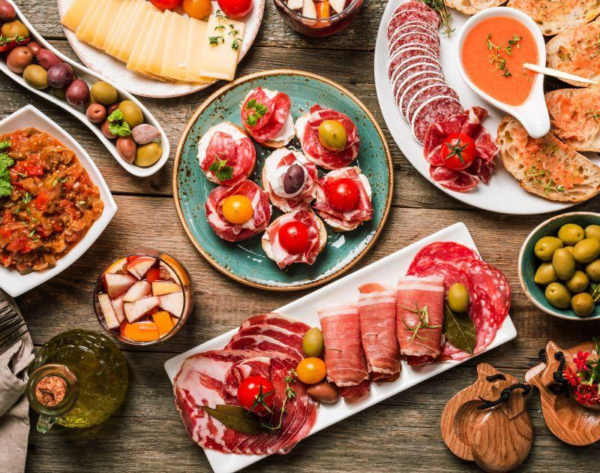Jamón ibérico, or Iberian ham, is a delicacy widely appreciated for its unique flavor and texture in all of Spain. It is arguably Spain’s most famous food. But cochinillo, or suckling pig, is a regional specialty from Castile and Léon is known for its tender and succulent meat.

Cured cheeses are also essential to Castile and Léon’s gastronomy, with varieties like Zamorano and Valdeón being particularly popular. And at any bar, you will be served small bite-sized foods called pinchos and tapas. These are also widely enjoyed in the region.
To some, this may sound like their average everyday meal, but to most of us international students, we have never heard of these dishes before arriving at IE in Segovia.
So what do some non-Spaniards have to say about these foods?
Table of Contents

Overall, Spanish cuisine differs from the cuisines of other countries in terms of flavors, ingredients, cooking techniques, dishes, and regional intricacies. These differences reflect the unique cultural and historical influences that have shaped each country’s culinary traditions.
To gain further insight into how non-Spanish IE students perceive their host country’s cuisine, specifically Castile and Léon’s cuisine, I interviewed four individuals of different nationalities.
The interviews revealed diverse opinions, highlighting the subjectivity of food and cultural preferences.
Most students tended to stay in their comfort zone, avoiding trying some of the more ‘daring’ or ‘unique’ dishes such as cochinillo. Most have at least tried the most famous traditional Spanish dishes like paella and have absolutely loved it.
From the perspective of an Argentine
Argentinian student Sofia Santiago found Spanish cuisine to be “it’s not that different from food in Argentina- I mean, it was colonized, so most of the food is pretty similar. So it’s just better or slightly different in some ways.”
However, she expressed disappointment at the lack of vegetarian options and how most dishes contained ham. She loves tortilla de patata, and when asked about patatas bravas, she said it’s just about “the best thing this country has to offer!” Like most non-Spaniards, Sofia did not particularly enjoy Gazpacho as she doesn’t” understand the appeal of ‘cold soup.’”
From the perspective of an Irelander
Irish student Ava Nun found Spanish cuisine unique and the opposite of anything she had ever eaten.
“It’s like the complete opposite of anything I’ve ever eaten. I grew up in China, so Chinese and Spanish food are opposites. But I think the shock comes from the fact that Spanish food is not big in other parts of the world like Chinese, Italian, or Indian food.”
She enjoys sangria and appreciated the cheap alcohol in Spain but felt that vegetables were not valued in Spanish cuisine.
From the perspective of a Lebanese
Lebanese student Ahmad Elbaba, who cannot eat pork due to religious restrictions, found Spanish cuisine restricting- “It’s in everything!” He found Spanish cuisine to lack vegetables and salads, making it less diverse regarding food groups.
“It’s a huge downgrade from Lebanese food, that’s for sure!”
From the perspective of a French
French student Francois Mari found jamón iberico and cured cheeses similar to French cuisine and didn’t view these foods as unique to Spain. He enjoyed tapas and pinchos but found Spanish cuisine to be too salty compared to that of France.
Overall, non-Spanish IE students have varying opinions about Spanish cuisine. While some find it unique and enjoyable, others find it too similar to their own cuisine or lacking diversity.
There is also a mixed response to specific dishes; some enjoy them, while others find them unappealing. Cultural background and personal taste play a significant role in how individuals perceive and enjoy different types of cuisine. This explains why some people love such a cuisine while others cannot stand the thought of it.
So, how does Spanish cuisine differ from the other cuisines that some of these students are accustomed to?
Spanish cuisine is known for its bold and intense flavors, emphasizing ingredients like garlic, paprika, saffron, and olive oil.
Argentinian focuses on all types of meats; Chinese cuisine has a wide range of flavors and ingredients, including soy sauce, ginger, and various types of seafood; Lebanese cuisine uses spices like cumin, coriander, and cinnamon, whilst French cuisine focuses on delicate and refined flavors, using butter, cream, and wine.
Like many other countries, Spanish cuisine varies widely depending on the region, and this is undoubtedly the case for the Castile and Léon region. Its cuisine features the heartiest dishes: cochinillo, chúleton de Ávila (beef rib steak). If you compare this to the cuisine from Andalusia, you will see that it is best known for its seafood dishes and use of sherry vinegar.
Click here to dicaover the 14 Spanish dished you should try!
However, I want to ask you: Has there been any shockingly good Spanish food?







